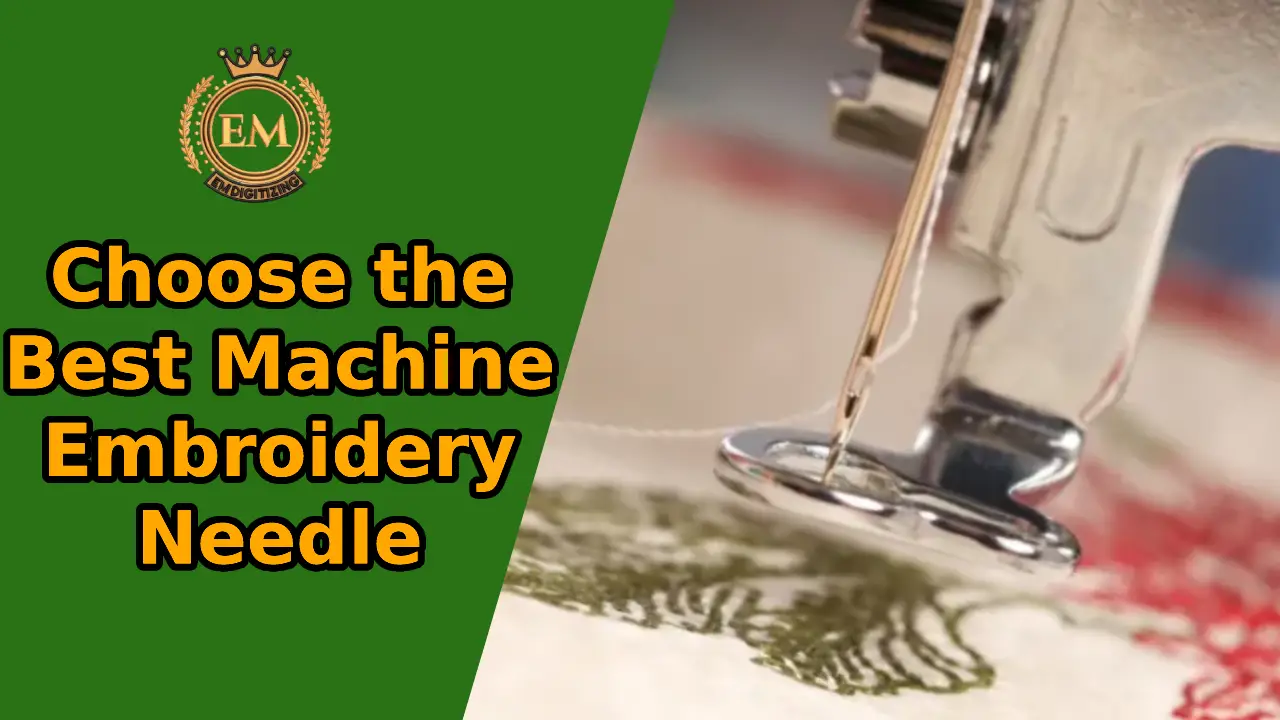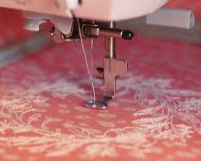
Considerando la trama e la densità del tessuto, il tipo di stabilizzatore, e anche il scelta del filo, puoi scegliere un ago che ti aiuterà a realizzare bellissimi ricami.
Così, perché è importante l'ago giusto??
Because it’;È importante quanto scegliere il materiale da ricamo giusto e portare avanti il tuo progetto nel modo giusto! Tutti questi piccoli fattori giocano un ruolo nella creazione di prodotti realizzati professionalmente che vorresti davvero mostrare o regalare.
Ago da ricamo
La parte piatta sulla parte superiore dell'ago è chiamata tibia e viene inserita nella macchina, la cui parte piatta è verso il retro.
Questo è seguito dall'albero, che è la parte rotonda della scanalatura attraverso la quale scorre il filo.
Questo è seguito dalla cruna dell'ago, che è un piccolo foro vicino alla punta dell'ago, o il suo suggerimento, attraverso il quale passa il filo.
Non c'è l'immagine di un piccolo solco chiamato sciarpa, che consente al gancio della macchina di sollevare il filo per cucire.
Differenza tra cucito vs. Ago per macchina da ricamo
A prima vista, gli aghi da cucito e gli aghi da ricamo sembrano molto simili. Ma, se guardi un po' più da vicino, vedrai la differenza. Gli aghi per macchina da cucire possono essere utilizzati per il ricamo a macchina, ma gli aghi da ricamo sono appositamente progettati per il massimo successo nei progetti di ricamo.
Gli aghi da ricamo hanno la cruna lunga, un ampio solco, e una sciarpa speciale per accogliere il filo da ricamo. Il grande occhio riduce l'attrito con il filo, che riduce la rottura e la frammentazione del filo.
La differenza principale tra un ago progettato per una macchina da ricamo e un ago normale per una macchina da cucire è la dimensione della cruna. Gli aghi ricamati hanno crune più grandi che consentono al filo di passare più facilmente. La piccola cruna di un normale ago per macchina da cucire può causare attrito e strappare il filo se viene utilizzata ricamo a macchina.
Servizi di digitalizzazione del ricamo
Tipi di aghi da ricamo
Quando si tratta di diversi tipi di aghi da ricamo, troverai aghi cromati e aghi rivestiti in titanio.
Aghi in acciaio cromato
Questo è il tipo più comune di materiale dell'ago. Infatti, questo è il materiale dell'ago predefinito, quindi se il materiale dell'ago è contrassegnato sulla confezione, è cromato. Questi aghi possono essere utilizzati con la maggior parte dei progetti di cucito e ricamo.
Aghi placcati in titanio
Questi aghi sono della massima qualità. Sono più forti, più durevole, e meno probabilità di surriscaldarsi, piegarsi o rompersi durante la cucitura della macchina da ricamo.
Inoltre, hanno un rivestimento che non solo li fa durare più a lungo, ma rende anche meno probabile che cadano sul materiale durante la cucitura. Se stai ricamando disegni di grandi dimensioni o utilizzando materiali duri o densi, poi, sotto la mano, potresti voler usare aghi di titanio.
La finitura dell'ago SCHMETZ Gold Titanium è resistente all'usura e al calore, permettendo all'ago di scivolare facilmente attraverso l'adesivo con una costruzione adesiva lenta.
Gli speciali aghi da ricamo rivestiti in teflon sono chiamati aghi anti-colla! Sono i miei preferiti quando cucio usando l'adesivo, stabilizzatori autoadesivi, o con reti realizzabili. L'ago è ottimo anche per ricamare su tessuti. Ciò riduce i residui nel canale del filo e nella cruna.
Dimensioni degli aghi per ricamo a macchina
sì, come gli altri aghi da cucito, gli aghi da ricamo sono disponibili in diverse dimensioni! Quando si fa riferimento alla dimensione dell'ago, you refer to the needle’;s larghezza nel punto. Di solito troverai due numeri per la taglia: dimensione metrica e dimensione americana.
Il 3 le dimensioni più comunemente utilizzate degli aghi da ricamo a macchina sono 75/11, 80/12, e 90/14 (non per macchine da ricamo domestiche, ma per macchine commerciali o multiago).
Dimensione 75/11 viene utilizzato per tessuti leggeri e tessuti intrecciati, 80/12 è migliore per tessuti di peso medio (come le trapunte, cotone, e biancheria), e 90/14 ricami su tessuti pesanti. Buono per (per esempio jeans e feltro).
Forme della punta dell'ago
Tre diversi tipi di forme delle punte sugli aghi da ricamo a macchina sono universali, Affilato, e penna a sfera.
1. Veloce
Gli aghi da ricamo affilati sono i più veloci e penetrano in profondità, tessuti intrecciati. A volte i progetti di copertura idrosolubile richiedono anche un ago affilato per perforare bene.
2. Penna a sfera
Aghi da ricamo con punta a sfera, d'altro canto, hanno una punta rotonda che spinge da un lato le fibre del tessuto invece di forarle e danneggiarle.
A volte è difficile trovare aghi da ricamo affilati e con punta a sfera, quindi potrebbe essere meglio usare un ago da cucito.
3. Universale
Gli aghi da ricamo universali hanno una punta leggermente arrotondata situata tra gli altri due tipi. così, gli aghi universali funzionano bene su tessuti non elastici e tessuti elastici.
A meno che la confezione dell'ago da ricamo non sia specificata diversamente, gli aghi da ricamo a macchina più comuni sono universali.
A meno che il tuo progetto non richieda esplicitamente diversamente (per esempio., filo metallico), inizia con un ago da ricamo universale, che è il tipo più comune.
Scegli il miglior ago per ricamo a macchina
Let’;Passiamo attraverso il processo di scelta di un ago in modo che tu possa imparare a farlo da solo!
1. Seleziona la dimensione dell'ago
Prima di tutto, considera il materiale che intendi ricamare.
Spessa e densa come la lana o la tela? Inizia alle 90/14.
Trapunte leggere o di peso medio come il cotone? Tentativo 75/11.
Molto leggero e delicato come vile, chiffon, o crêpe? Forse anche 70/10 o 65/9.
nessuna idea? 75/11 è un ottimo punto di partenza.
Secondo, controlla se la selezione del filo funzionerà con la dimensione dell'ago. Se non regolerà la dimensione.
Fili più spessi (piccoli numeri in peso) richiedono un ago grosso con una cruna grande. Per 30 fili in peso, Mi piace ridimensionare 80/12.
Filo sottile (grande peso) funziona meglio con aghi sottili e occhi piccoli. Utilizzando 60 peso del filo? Con questo 70/10 iniezione, la tua fortuna potrebbe migliorare.
infine, assicurati che la dimensione dell'ago funzioni con il tuo disegno da ricamo.
Se cucire è molto complicato, progettazione dettagliata, considera un piccolo, ago affilato che realizzerà i piccoli fori dell'ago in modo più accurato.
2. Scegli un tipo di ricamo.
Prima di tutto, pensa al tessuto che ricamerai.
Molto allungato, i tessuti intrecciati funzionano bene con una penna a sfera o universale. La maggior parte dei tessuti a maglia funziona bene con aghi universali o affilati. Potrebbe essere necessario che questo ago affilato penetri molto spesso, tessuti molto spessi (denim, tela, vinile).
In caso di confusione, prova prima un ago da ricamo universale.
If an embroidery needle doesn’;t lavorare con il tuo progetto, scegli un ago per macchina da cucire con una punta corrispondente. Per esempio, i fili di metallo e i fili che si illuminano al buio richiedono un punto superiore o un ago di metallo.
In genere, quando si utilizza un ago da cucito invece di un ago da ricamo, inizia con la dimensione più grande dell'ago da cucito per assicurarti che la cruna dell'ago sia abbastanza grande da regolare il filo da ricamo senza attriti. Potrebbe fare
Prossimo, considera la scelta del tuo stabilizzatore. Se stai usando una copertura solubile in acqua, e l'ago universale non fora, potresti aver bisogno di un ago affilato.
3. Decidi il rivestimento
Anche se non c'è alcun lato negativo (altro che il prezzo) utilizzando sempre aghi con rivestimento speciale, alcuni esempi richiedono aghi in titanio o rivestiti in oro.
I especially like coated needles when I’;sto ricamando molto spesso, tessuti spessi come denim o tela, especially if I’;Sto usando un adesivo, stabilizzatore autoadesivo.
Altri consigli per la risoluzione dei problemi dell'ago
- Prima di acquistare, leggi il manuale dell'utente per determinare se il gambo dell'ago è adatto alla tua macchina. La maggior parte delle case utilizza macchine da ricamo che funzionano con normali steli piatti, ma alcune macchine commerciali utilizzano aghi a gambo rotondo. Anche, alcune macchine da ricamo domestiche consigliano di non ricamare con aghi più grandi di 90/14.
- Cambiare ripetutamente l'ago per una cucitura corretta. La rottura del filo o la scarsa penetrazione possono essere causate da una piegatura, debole, o ago appuntito. Ognuno ha un'idea diversa riguardo al momento giusto per cambiare l'ago, ma cambio idea almeno ogni 10 ore dopo la cucitura attiva.
- Conserva l'ago nella sua custodia originale o nell'apposita area di conservazione dell'ago se devi estrarlo temporaneamente. That way you can remember what size and type of needle it was and you don’;Non devi preoccuparti di allentarlo riponendolo liberamente in una scatola con altri.
Conclusione
Spero che tu abbia imparato di più sugli aghi da ricamo a macchina e su come scegliere il tipo e la dimensione che produrranno i migliori risultati per il tuo progetto.
Se sei nuovo al ricamo e ti senti sopraffatto, essere pazientare, ed esercitati e presto ti ritroverai a ricamare come un professionista!
Il diametro dell'ago che scegli dovrebbe essere sempre uguale alla larghezza del filo che utilizzerai. Per esempio, se l'ago è troppo stretto, il filo non passerà facilmente attraverso il tessuto dell'ago, che può danneggiare il filo. Ciò porta spesso a litigi e terribili offuscamenti.
Sebbene entrambi possano essere utilizzati per il ricamo a macchina, la differenza principale tra gli aghi da ricamo e quelli per macchina da cucire è la forma della cruna e della sciarpa. Gli aghi ricamati a macchina hanno una cruna allungata e una sciarpa dalla forma speciale che si adatta ai fili da ricamo più delicati e non consente loro di rompersi o accendersi.
90/14 –; Adatto per tessuti di peso medio, come il cotone leggero, poliestere, biancheria, e tessuto da rivestimento leggero. Tessuti leggeri come la seta (chiffon, organza, crêpe de chine) richiederà un ago più piccolo. Più leggero è il tessuto, più piccolo sarà l'ago necessario.
Gli aghi da ricamo sono generalmente leggermente diversi dagli altri tipi di aghi da cucito: la punta è meno affilata, and the eye and the eyelet –; (il piccolo foro per il filo) è leggermente più grande. Tuttavia, per scopi speciali, gli aghi da cucito vengono utilizzati per i ricami, come per il ricamo su pelle o jeans.
I loro bordi affilati li rendono perfetti per perforare tessuti di fondo a trama fitta e la loro cruna leggermente più lunga si adatta a fili da ricamo di diversi pesi.
